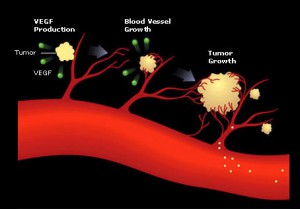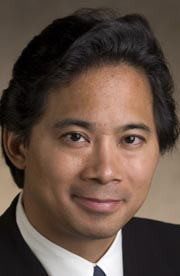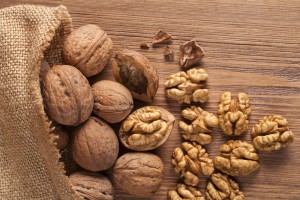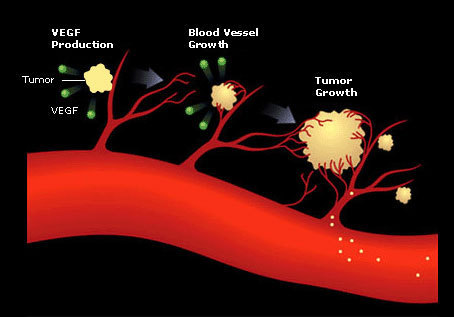Thinking about Blood
Blood carries nutrients and oxygen to the cells and waste products from the cells. Blood vessels—capillaries, arteries, veins—carry that blood throughout the body. Obviously blood vessels are important to life.
The tissues in our body produce compounds that enhance the growth of blood vessels and that stop the growth of blood vessels. Angiogenesis is the medical term for growth of new blood vessels in the body.
It may be surprising to know that cancers rely on blood vessel growth. In fact, cancer cells need a  blood supply to get started; and out-of-control blood vessel growth to keep growing. Cancer cells produce angiogenic growth factor proteins that stimulate blood vessels growth.
blood supply to get started; and out-of-control blood vessel growth to keep growing. Cancer cells produce angiogenic growth factor proteins that stimulate blood vessels growth.
So one of the ways to stop cancer growth is to stop blood vessel growth, anti-angiogenesis.
The Angiogenesis Foundation
 Although there have been many researchers who have done significant research on angiogenesis, Dr. William Li has been the most recent and visible proponent of finding new ways to intervene when angiogenesis goes out of balance in the body. He has created The Angiogenesis Foundation.
Although there have been many researchers who have done significant research on angiogenesis, Dr. William Li has been the most recent and visible proponent of finding new ways to intervene when angiogenesis goes out of balance in the body. He has created The Angiogenesis Foundation.
As Dr. Li states, tiny harmless cancers are present in all adult bodies. These only become harmful if they are able to establish a blood supply. “Angiogenesis is a tipping point between a harmless cancer and a harmful one,” he says in his TEDx presentation. But the tumor blood vessels are not well organized and so are “highly vulnerable” to anti-angiogenic treatment. “A key mechanism of anti-angiogenic therapy interferes with the process of blood vessel growth to literally starve the tumor of its blood supply,” he states. Since 2004, several anti-angiogenic medications have been added to cancer treatments, including Bevacizumab, Cabozantinib, Pazopanib, Regorafenib, Sorafenib, Sunitib, Vandetanib and Ziv-Aflibercept.
Angiogenesis and Eating to Beat Cancer
But there is more to Dr. Li and other researchers work in angiogenesis. Many foods have been found to contain naturally occurring compounds with important anti-angiogenetic properties. To increase the general public’s understanding of, and to share knowledge gained in, research about angiogenesis, Dr. Li also started a website called Eat to Beat Cancer.
He believes that food can be used to “beat back cancer” or even “prevent cancer.” Some of the naturally occurring compounds in food include
Resveratrol in red grapes, Gllagic acid in strawberries, Genestein soy beans and Isothiocyanates in broccoli and other “cruciferous” vegetables.
Many animal studies, epidemiological studies and even case-control studies are available that support his excitement. Here are three examples.
For example, in a 2012 animal study , mice injected with a human colorectal  tumor were fed either a diet supplemented with walnuts or with corn oil (control). The growth of the tumor in the mice that were fed walnuts was significantly slower (27%) than in the mice (43%) fed corn oil.
tumor were fed either a diet supplemented with walnuts or with corn oil (control). The growth of the tumor in the mice that were fed walnuts was significantly slower (27%) than in the mice (43%) fed corn oil.
The Iowa Women’s Health Study used a food frequencies questionnaire to learn about the nutrition and health status of over 35,000 women over several years. One evaluation found that eating cruciferous vegetables and especially broccoli was associated with a lower risk of non-Hodgkin’s lymphoma.
A recent study (2014) published in Prostate Cancer and Prostatic Disease supports the notion that increasing foods such as pomegranate, green tea, broccoli and turmeric can be beneficial. One hundred ninety-nine men took part in this double blind, placebo controlled randomized trial. All of these men were under active surveillance or watchful waiting after being diagnosed with localized prostate cancer. One group received a placebo and the other group received receive an oral capsule containing a blend of pomegranate, green tea, broccoli and turmeric supplement for 6 months. The study monitored the rise in PSAs for each group. The median rise PSAs of the group receiving the capsule with the food supplement blend was 14.7% the placebo groups median rise PSA was 78.5%. The statistically significant difference was 63.8%.
How You Cook Matters
One of the features that makes Eat to Beat Cancer website unique is the discussion on how to prepare your foods that are high in anti-angiogenic properties.
For example, broccoli and other cruciferous foods are best if steamed rather than boiled because it preserves the glucosinolates (which convert to isothiocyanates in the body) which are anti-angiogenic. Earl Gray tea is high in anti-angiogenic catechins: the best way to drink it is to steep it for at least 5 minutes and dunk the tea bag allowing more release of the compound. And the best way to eat tomatoes, which contain lycopene? Give them a 15 minute simmer in olive oil.
The Bottom Line
Dr. Li is enthusiastic but it would be nice if, in his presentations-on television or videos- he would provide the name of a study’s lead author and not just the statistic that supports his statements. Perhaps that is why Eat to Beat Cancer includes references and an evidence section.
But what it all boils down to is what our mothers always said when setting our plates on the table, “Eat your vegetables!”
Feature Image by Rene Cortin / CC BY-SA (https://creativecommons.org/licenses/by-sa/4.0)







These are over-hyped claims. The walnut diet resulted in slower growth, NOT a cure for cancer. Most food studies show slower growth, not a cure. Each cancer is unique, even from the same person. That means that each tumor became malignant in a different way. Saying that a certain food or combination of foods will prevent cancer is far-fetched. There is more to cancer than angiogenesis. There are huge mutations and chromosomal rearrangements that are advantageous for growth. I’m an epigeneticist by training, and I know the power of what you eat and your environment. However, I’m very skeptical of claims that food can cure. There is no evidence for this. Food can slow the growth, but not cure.
I agree with you. Thank you for expressing your skepticism here.
However, by adding foods that support slower or no growth, additional means to eradicate the cancer can be much more efficient and successful. It is just as likely as a certain percentage of the population to be “cured” by this as to be “cured” by traditional means of poisoning the body with chemicals. Both CAN work. But no one can say both DO work as those implementing one system of treatment alone can never work 100% of the time anyway. Neither system alone cures cancer. But it’s obvious what our foods do within the body play a larger role in regaining and maintaining health than our modern society has given credit for. We are very much what we eat. What we eat builds our very cells or impacts them negatively.
You’ve outdone yourself here. Nice.
I’m so glad Dr Li endorses sourdough bread. An average sandwich with 2 slices of ‘normal’ bread digests to over 10 teaspoons of sugar. And if there is a donut sonewhere that only has 1-1\2 spoons of sugar, where is it? What we don’t eat is perhaps more important
This is dumb. Your body need angiogenisis. Healthy angiogenisis or proper angiogenisis helps fight cancer too.